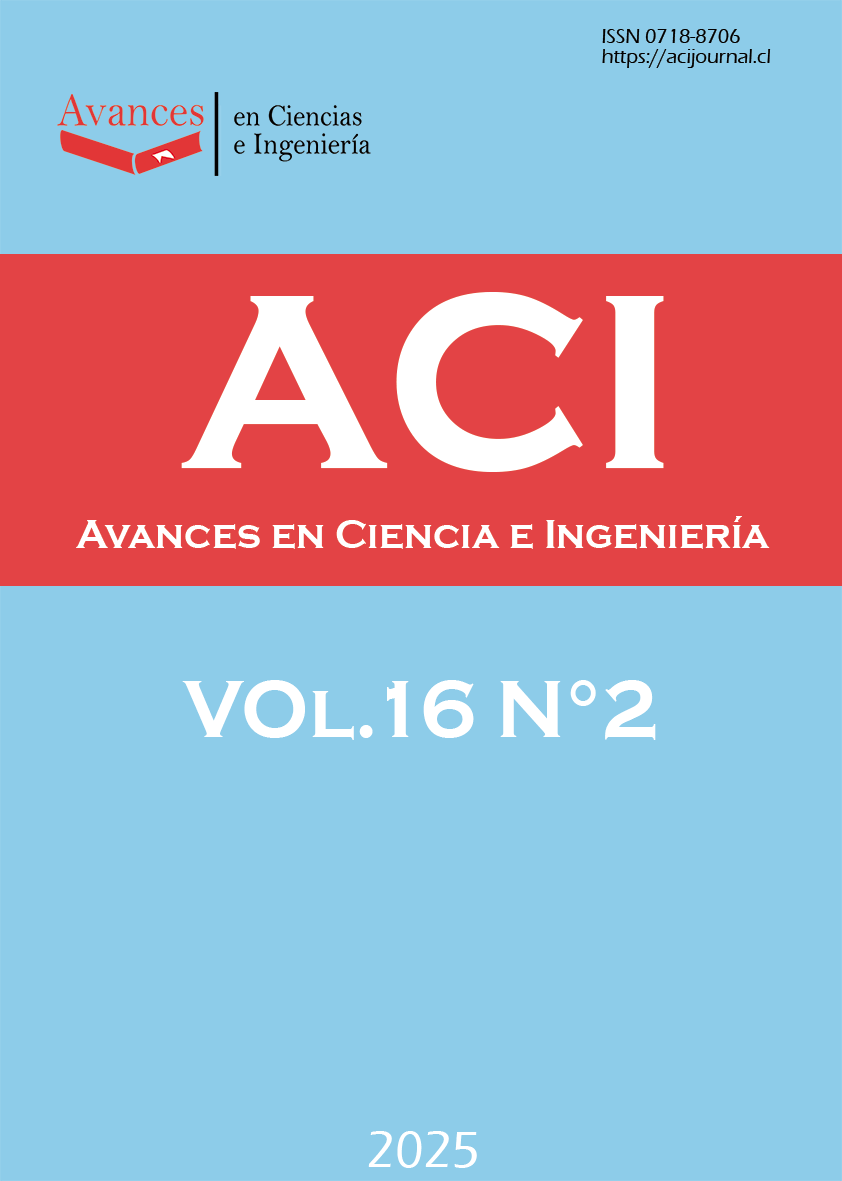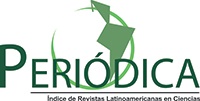Síntesis y caracterización de derivados O-acilados y O-alquilados de lawsona
DOI:
https://doi.org/10.65093/aci.v16.n2.2025.27Palabras clave:
1,4 naftoquinonas, lawsona, derivados O-acilados, síntesis orgánicaResumen
Las naftoquinonas son compuestos orgánicos con amplia relevancia biológica y aplicaciones en química médica y agrícola. En este trabajo se describe la síntesis de los derivados conocidos de lawsona (1), 2‑acetoxi (2) y 2‑metoxi (3) de, junto con cuatro nuevos compuestos O‑acilados (4–7) obtenidos mediante reacciones de O‑alquilación y O‑acilación. Los productos fueron caracterizados por FT‑IR, RMN 1D y 2D, y espectrometría de masas de alta resolución (EMAR), confirmando sus estructuras. Los rendimientos oscilaron entre 49,3 % y 89,2 %, observándose variaciones atribuibles a la naturaleza del grupo acilo. Estos resultados establecen la base para estudios posteriores orientados a evaluar la actividad antifúngica frente a fitopatógenos de importancia agrícola.
Descargas
Citas
Bhupinder, P.S. & Khambay, P.J. (2000). The potential of natural naphthoquinones as the basis for a new class of pest control agents—An overview of research at IACR-Rothamsted. Crop Protection, 19, 597–601. https://doi.org/10.1016/S0261-2194(00)00078-8
Campos-Takaki, G.M., Steiman, R., Seigle-Murandi, F., Silva, A.A. & Bieber, L. (1992). Effect of medium composition on the antifungal susceptibility tests to lapachol, β-lapachone, phthiocol and its synthetic analogs. Rev. Microbiol., 23, 106–111.
Dash, A., Panda, J., Samanta, B. & Mohapatra, S. (2025). Advancements in synthetic methodologies and biological applications of lawsone derivatives. Organic & Biomolecular Chemistry, 23 (10), 2302-2322. https://doi.org/10.1039/D5OB00020C
De Simone, R.W., Currie, K.S., Mitchell, S.A., Darrow, J.W. & Pippin, D.A. (2004). Privileged Structures: Applications in Drug Discovery. Comb. Chem. High Throughput Screen., 7, 473–491. https://doi.org/10.2174/1386207043328544
Dekkers, J., Kooijman, H., Kroon, J. & Grech, E. (1996). 2-Hydroxy-1,4-naphthoquinone. Acta Cryst., C52, 2896–2899. https://doi.org/10.1107/S0108270196007664
Durán, A.G., Chinchilla, N., Molinillo, J.M. & Macías, F.A. (2018). Influence of lipophilicity in O-acyl and O-alkyl derivatives of juglone and lawsone: A structure–activity relationship study in the search for natural herbicide models. Pest Manag. Sci., 74, 682–694. https://doi.org/10.1002/ps.4764
Dweck, A.C. (2002). Natural ingredients for colouring and styling. Int. J. Cosmet. Sci., 24, 287–302. https://doi.org/10.1046/j.1467-2494.2002.00148.x
Hui, Y., Khim Chng, E.L., Lin Chng, C.Y., Poh, H.L. & Webster, R.D. (2009). Hydrogen-Bonding Interactions between Water and the One- and Two-Electron-Reduced Forms of Vitamin K1: Applying Quinone Electrochemistry to Determine the Moisture Content of Non-Aqueous Solvents. J. Am. Chem. Soc., 131, 1523–1534. https://doi.org/10.1021/ja8080428
Lamoureux, G., Perez, A.L., Araya, M. & Agüero, C. (2008). Reactivity and Structure of derivatives 2-hydroxy-1,4-naphthoquinone (lawsone). J. Phys. Org. Chem., 21, 1022–1028. https://doi.org/10.1002/poc.1435
López, L., Leyva, E. & García de la Cruz, R.F. (2011). Las naftoquinonas: más que pigmentos naturales. Rev. Mex. Cienc. Farm., 42, 6–17.
Munday, R., Smith, B.L. & Munday, C.M. (2007). Structure–activity relationships in the haemolytic activity and nephrotoxicity of derivatives of 1,2- and 1,4-naphthoquinone. J. Appl. Toxicol., 27, 262–269. https://doi.org/10.1002/jat.1206
Ogawa, M., Koyanagi, J., Sugaya, A., Tsuda, T., Ohguchi, H., Nakayama, K., et al. (2006). Cytotoxic Activity toward KB Cells of 2-Substituted Naphtho[2,3-b]furan-4,9-diones and Their Related Compounds. Biosci. Biotechnol. Biochem., 70, 1009–1012. https://doi.org/10.1271/bbb.70.1009
Ravelo, A.G., Estevez-Braun, A., Chavez-Orellana, H., Perez-Sacau, E. & Mesa-Siverio, D. (2004). Recent Studies on Natural Products as Anticancer Agents. Curr. Top. Med. Chem., 4, 241–265. https://doi.org/10.2174/1568026043451500
Rostkowska, H., Nowak, M.J., Lapinski, L. & Adamowicz, L. (1988). 2-hydroxy-1,4-naphthoquinone; Experimental matrix isolation and theoretical Hartree-Fock and post Hartree-Fock study. Spectrochim. Acta Part A Mol. Biomol. Spectrosc., 54, 1091–1103. https://doi.org/10.1016/S1386-1425(98)00032-8
Rungrojrattikorn, K., Manuschai, J., Suwanhom, P., Kara, J., Lomlim, L. & Naorungroj, S. (2024). In vitro evaluation of 2-(chloroalkyloxy)naphthalene‑1,4‑dione derivatives as anticaries agents. ScienceAsia, 50 (5), Article 098. https://doi.org/10.2306/scienceasia1513-1874.2024.098
Shahid Khan, M. & Khan Zahid, H. (2005). Ab initio and semiempirical study of structure and electronic spectra of hydroxy substituted naphthoquinones. Spectrochim. Acta Part A Mol. Biomol. Spectrosc., 61, 777–790. https://doi.org/10.1016/j.saa.2004.04.027
Song, R., Yu, B., Friedrich, D., Li, J., Krautscheid, H.H., Huang, S.D. & Kim, M.-H. (2020). Naphthoquinone-derivative as a synthetic compound to overcome the antibiotic resistance of methicillin-resistant S. aureus. Commun. Biol., 3, 529. https://doi.org/10.1038/s42003-020-01261-0
Sujathan Nair, A., Sekar, M., Hua Gan, S., Kumarasamy, V., Subramaniyan, V., Seng Wu, Y., et al. (2024). Lawsone Unleashed: A Comprehensive Review on Chemistry, Biosynthesis, and Therapeutic Potentials. Drug Des. Dev. Ther., 18, 3295–3311. https://doi.org/10.2147/DDDT.S463545
Xiang, S., Li, Y., Khan, S. N., Zhang, W., Yuan, G. & Cui, J. (2025). Exploiting the anticancer, antimicrobial and antiviral potential of naphthoquinone derivatives: Recent advances and future prospects. Pharmaceuticals, 18 (3), 350. https://doi.org/10.3390/ph18030350
Descargas
Publicado
Cómo citar
Número
Sección
Licencia

Esta obra está bajo una licencia internacional Creative Commons Atribución-NoComercial-SinDerivadas 4.0.









